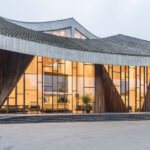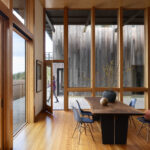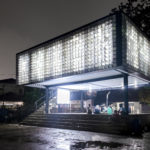It’s been a pretty tough month for Zaha Hadid Architects, with the much-publicized cancellation of the firm’s Tokyo 2020 Olympic Stadium — swiftly followed by a robust response to the world’s media. However, better news for the practice arrived this week in the shape of MMM Corones, a mountain museum atop an Alpine peak that forms the sixth and final architectural tribute to one of the most extraordinary explorers in history, Reinhold Messner — the first person to summit all 14 of the world’s highest peaks and to climb Everest without supplemental oxygen.

MMM stands for “Messner Mountain Museum”, a project founded by the famous climber that aims to tell the stories of mountains and mountaineering culture within six different locations across the Alps of South Tyrol, an autonomous province of Italy. Messner’s exhibition spaces are housed within architecture of incredible diversity: MMM Firmian, for instance, is located within Sigmundskron Castle, a 1,000-year-old fortified construction that was meticulously renovated by local firm Werner Tscholl Arkitect.

ZHA’s completed design stands in perfect contrast to that age-old structure. While MMM Firmian is contained by 15-feet-thick walls of textured stone, the Corones museum comprises a series of polished concrete pods embedded within the mountainside like docked spaceships from Hadid’s personal architectural future. According to ZHA, exhibition spaces and a small auditorium have been carved into the summit of Mount Kronplatz as “a composition of fluid, interconnecting volumes” informed by the specific geology and topography of this dramatic location.

An angular wall of glazing marks the entrance, which the architect compares to a “fragment of glacial ice.” From here, visitors descend into the heart of the mountain via cascading ramps and staircases of fluid concrete, evoking the metamorphosis of rocks and lava flows through subterranean chasms. Along the way, items collected by Messner throughout his lifetime are displayed, including everything from mountaineering equipment to panoramic paintings of infamous peaks, each one bringing memories of great triumph and terrible tragedy to the fore.

© Harald Wisthaler
Perhaps surprisingly, Zaha Hadid’s signature brand of parametric design appears more at home within this sweeping natural landscape than most urban locations around the globe. The decision to bury a large proportion of the exhibition spaces underground brings a degree of subtlety to the juxtaposition between natural and manmade elements; ZHA’s characteristically futuristic forms peak out from the side of the mountain like the proverbial tips of a curvaceous concrete iceberg.

These are unmistakably modern moments within an ancient landscape, but the contrast works — similarities can be drawn with Reiulf Ramstad’s stunning mountaintop tourist route in Trollstigen, Norway, a bold composition of sculpted concrete and Corten steel. Indeed, Ramstad’s contemporary viewing platform may now have a rival to the throne for modern architecture’s most epic panorama: the climax of each visitor’s journey through MMM Corones arrives as they step out onto the observation deck, a cantilevered ledge of concrete that provides staggering views across the Zillertal Alps, the Dolomites, and the Marmolada Glacier.

While some will be wary of Hadid’s ubiquitous style finding its way from the world’s metropolises to a remote outpost of Alpine wilderness, this structure is an exhibition in restraint from an architect often associated with formal exuberance. It is reminiscent of a cliffside cave in which Reinhold himself might once have sheltered from the elements during one of his daring expeditions up some of the most dangerous rock faces on the planet.
Most poignantly of all, the museum’s content tells the story of intrepid adventurers deep within the rugged terrain upon which those very people blazed their trails. The marriage of function and context here is clearer than ever, and Zaha Hadid’s design honors that connection with a customary dash of modern flair.









